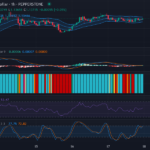
Mixed Signals: A Comprehensive Analysis of EUR/USD – 18/04/2025
Tháng 4 17, 2025
David Hogg’s $20 Million Initiative: A Bold Move to Revitalize the Democratic Party
Tháng 4 17, 2025Mark Carney’s Strategic Stance Amid U.S.-Canada Trade Tensions
In the wake of escalating trade tensions between Canada and the United States, Mark Carney, a prominent Canadian official, has made a clear decision regarding tariffs: Canada will not implement a dollar-for-dollar response to the U.S. tariffs imposed under President Donald Trump’s administration. This decisive stance comes as both nations grapple with significant economic repercussions stemming from these trade disputes.
Understanding Tariff Impacts Between Canada and the U.S.
The trade relationship between Canada and the United States has historically been characterized by deep economic integration, with Canada exporting approximately three-quarters of its goods to its southern neighbor. However, recent developments, particularly Trump’s imposition of major tariffs—25 percent on Canadian goods and 10 percent on energy exports—have strained this once-close partnership. The resultant retaliatory measures from Canada have sparked further tensions, undermining the fabric of bilateral trade.
Carney’s decisions reflect a calculated move to mitigate the risk of a full-scale trade war that could yield adverse consequences for both economies. He recognizes that a direct retaliatory approach would only exacerbate the existing turmoil and potentially cripple the interconnected supply chains relied upon by both nations. For example, tariffs placed on Canadian softwood pulp threaten the consistent supply vital to American manufacturers, revealing how far-reaching these economic policies can be.
Indeed, the backlash from Canadians has been palpable, with numerous individuals canceling business trips to the U.S. amid fears that border relations are deteriorating. This series of retaliatory measures and heightened tensions signals a critical period for both nations, as political and economic uncertainties loom large.
Alternative Solutions and Future Directions
In light of these challenges, Canada is actively looking to strengthen its internal trade dynamics, explore new partnerships with entities such as the European Union, and bolster domestic industries. These efforts aim to create a more resilient economic framework that doesn’t rely solely on the U.S. market, which currently dominates Canada’s export landscape. For further insights on the broader economic interactions and trading dynamics that Mark Carney must navigate amid U.S.-Canada trade tensions, check out the blog discussing the neutral forex market trend between the U.S. Dollar and Canadian Dollar here.
Furthermore, the political climate in Canada is shifting, with upcoming elections providing an opportunity for a reevaluation of the country’s approach to its relationship with the United States. There is a collective hope among many Canadians that new leadership could steer the nation toward a more constructive dialogue with its neighbor, thus easing tensions and fostering a more collaborative atmosphere.
In summary, Mark Carney’s rejection of a strict dollar-for-dollar tariff matching policy indicates a priority for strategic, measured responses rather than immediate retaliation. This careful consideration is paramount in the face of deteriorating relations and the pressing need for both countries to navigate the complexities of trade with prudence and foresight. With the landscape continually evolving, the path forward remains uncertain but offers a potential for reconciliation and renewed partnerships. For more context on China’s strategic responses to U.S.-China trade tensions and implications for global economic stability, you can read about it here.
